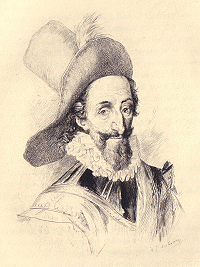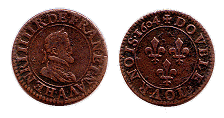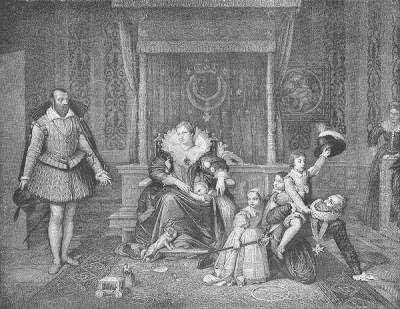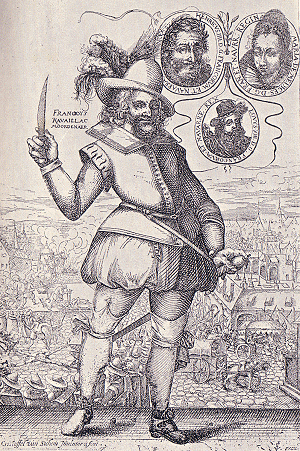
or

HENRI IV OF FRANCE
On the 1st of August 1589, the last of Marguerite's surviving brothers and last in the Valois line of Kings, Henri III of France was attacked by the fanatical monk Jacques Clement. Shortly before his death on August the 2nd, Henri III of France, named Henri III of Navarre as his successor.
Despite the endorsement of Henri III of France, many people would not accept a Protestant as their King, and Henri of Navarre had to continue to do battle with the Catholic league, which received strong support from Spain.
On the 21st of September 1589, King Henri IV engaged the Duke of Mayenne at Arques, on the north coast near Dieppe. Henri's force of a few thousand men, managed to repel the much larger forces of the catholic league. Shortly after this Henri received reinforcements from Elizabeth I of England, as well as the Count de Soissons and others.
On the 14th of March 1590 Henri again did battle with Mayenne, this time at Ivry to the west of Paris. Again King Henri IV prevailed. However the catholic league retained a strong grip on Paris.
On the 25th of July 1593, Henri III of Navarre converted back to the Catholic faith, which led to him being officially crowned as Henri IV of France at Chartres, on the 27th of February 1594. Henri is reputed to have said that "Paris is worth a Mass". It still took him until 22nd of March 1594 and the bribing of key officials before he was able to enter and claim Paris.

Henri IV
Many Protestants were disappointed, that the man they had supported, had renounced their faith for a second time. Many Catholics didn't believe his conversion was sincere. In the middle ground were men like Henri himself of both religions, who realised that for France to recover from the turmoil of the religious wars, the two religions needed to live peacefully side by side.
Henri used his new influence to draft the Edict of Nantes, which was signed in 1598, and which gave Protestants freedom to practice their faith in what was still predominantly catholic France.
Henri's marriage to Marguerite of Valois had not been a successful one, and had not produced an heir. Henri had mistresses and Marguerite herself was reputed to have had many lovers. In 1599, the marriage between Henri and the daughter of the scheming Catherine de Medici was annulled.
No doubt, many people were surprised, including at least one of Henri's mistresses, when in the autumn of 1600, Henri then married Marie de Medici from Florence. This marriage was more fruitful and produced several children, the first being born on the 27th of September 1601, the future Louis XIII of France.

Henri IV Double Tournois coin from 1604
Henri now set about rebuilding the finances and infrastructure of the united Kingdoms of France and Navarre, which had been devastated by the lengthy wars of religion. His long time trusted friend and life long Protestant, the Duke of Rosny, proved to be not only a brave soldier, but also financially very astute. Rosny was promoted in 1606 and from then on became known as the Duke of Sully. Henri became famous for another saying which was attributed to him, "A chicken in every peasant's pot, every Sunday".

Henri IV at home with Marie and children
Because Henri planned to be absent for long periods on state business, Marie of Medici was crowned as Queen on the 13th of May 1610, so that she could act in his place while he was away.
On the 14th of May 1610 in Paris, Francois Ravaillac stepped out the shadows and stabbed Henri IV of France to death. Henri's son Louis XIII was still only eight years old, so Marie was appointed as Regent.

Francois Ravaillac
Much like Catherine de Medici had before her, Marie de Medici now became the power behind the throne of France.
